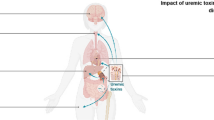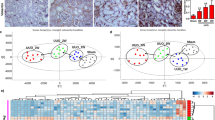Abstract
Chronic kidney disease (CKD) is the 16th leading cause of mortality worldwide. Clinical studies have raised that long-term use of omeprazole (OME) is associated with the morbidity of CKD. OME is commonly used in clinical practice to treat peptic ulcers and gastroesophageal reflux disease. However, the mechanism underlying renal failure following OME treatment remains mostly unknown and the rodent model of OME-induced CKD is yet to be established. We described the process of renal injury after exposure to OME in mice; the early renal injury markers were increased in renal tubular epithelial cells (RTECs). And after long-term OME treatment, the OME-induced CKD mice model was established. Herein, aryl hydrocarbon receptor (AHR) translocation appeared after exposure to OME in HK-2 cells. Then for both in vivo and in vitro, we found that Ahr-knockout (KO) and AHR small interfering RNA (siRNA) substantially alleviated the OME-induced renal function impairment and tubular cell damage. Furthermore, our data demonstrate that antagonists of AHR and CYP1A1 could attenuate OME-induced tubular cell impairment in HK-2 cells. Taken together, these data indicate that OME induces CKD through the activation of the AHR-CYP axis in RTECs. Our findings suggest that blocking the AHR-CYP1A1 pathway acts as a potential strategy for the treatment of CKD caused by OME.
Key messages
-
We provide an omeprazole-induced chronic kidney disease (CKD) mice model.
-
AHR activation and translocation process was involved in renal tubular damage and promoted the occurrence of CKD.
-
The process of omeprazole nephrotoxicity can be ameliorated by blockade of the AHR-CYP1A1 axis.








Similar content being viewed by others
Availability of data
The authors declare that all data supporting the findings are available within the article and Supplementary information files. The source data are available from the corresponding author. The publicly available online data about human renal transcriptomics used in this study are available in the Nephroseq database (http://v5.nephroseq.org), which ‘Ju CKD Tublnt’ dataset is analyzed in the present study.
References
Chen TK, Knicely DH, Grams ME (2019) Chronic kidney disease diagnosis and management: a review. JAMA 322:1294–1304. https://doi.org/10.1001/jama.2019.14745
Foreman KJ, Marquez N, Dolgert A, Fukutaki K, Fullman N, McGaughey M, Pletcher MA, Smith AE, Tang K, Yuan CW et al (2018) Forecasting life expectancy, years of life lost, and all-cause and cause-specific mortality for 250 causes of death: reference and alternative scenarios for 2016–40 for 195 countries and territories. Lancet 392:2052–2090. https://doi.org/10.1016/S0140-6736(18)31694-5
Radhakrishnan J, Perazella MA (2015) Drug-induced glomerular disease: attention required! Clin J Am Soc Nephrol 10:1287–1290. https://doi.org/10.2215/CJN.01010115
Poly TN, Islam MM, Walther BA, Lin MC, Li YJ (2022) Proton pump inhibitors use and the risk of pancreatic cancer: evidence from eleven epidemiological studies, comprising 1.5 million individuals. Cancers (Basel) 14(21):5357. https://doi.org/10.3390/cancers14215357
Kamada T, Satoh K, Itoh T, Ito M, Iwamoto J, Okimoto T, Kanno T, Sugimoto M, Chiba T, Nomura S et al (2021) Evidence-based clinical practice guidelines for peptic ulcer disease 2020. J Gastroenterol 56:303–322. https://doi.org/10.1007/s00535-021-01769-0
Vaezi MF, Yang YX, Howden CW (2017) Complications of proton pump inhibitor therapy. Gastroenterology 153:35–48. https://doi.org/10.1053/j.gastro.2017.04.047
Lazarus B, Chen Y, Wilson FP, Sang Y, Chang AR, Coresh J, Grams ME (2016) Proton pump inhibitor use and the risk of chronic kidney disease. JAMA Intern Med 176:238–246. https://doi.org/10.1001/jamainternmed.2015.7193
Xie Y, Bowe B, Li T, Xian H, Balasubramanian S, Al-Aly Z (2016) Proton pump inhibitors and risk of incident CKD and progression to ESRD. J Am Soc Nephrol 27:3153–3163. https://doi.org/10.1681/ASN.2015121377
Blank ML, Parkin L, Paul C, Herbison P (2014) A nationwide nested case-control study indicates an increased risk of acute interstitial nephritis with proton pump inhibitor use. Kidney Int 86:837–844. https://doi.org/10.1038/ki.2014.74
Muriithi AK, Leung N, Valeri AM, Cornell LD, Sethi S, Fidler ME, Nasr SH (2014) Biopsy-proven acute interstitial nephritis, 1993–2011: a case series. Am J Kidney Dis 64:558–566. https://doi.org/10.1053/j.ajkd.2014.04.027
Fontecha-Barriuso M, Martin-Sanchez D, Martinez-Moreno JM, Cardenas-Villacres D, Carrasco S, Sanchez-Nino MD, Ruiz-Ortega M, Ortiz A, Sanz AB (2020) Molecular pathways driving omeprazole nephrotoxicity. Redox Biol 32:101464. https://doi.org/10.1016/j.redox.2020.101464
Xie Y, Bowe B, Li T, Xian H, Yan Y, Al-Aly Z (2017) Long-term kidney outcomes among users of proton pump inhibitors without intervening acute kidney injury. Kidney Int 91:1482–1494. https://doi.org/10.1016/j.kint.2016.12.021
Kia L, Kahrilas PJ (2016) Therapy: risks associated with chronic PPI use - signal or noise? Nat Rev Gastroenterol Hepatol 13:253–254. https://doi.org/10.1038/nrgastro.2016.44
Lazarus B, Carrero JJ (2020) Long-term renal effects of proton pump inhibitor use. Gastroenterology 158:1173–1174. https://doi.org/10.1053/j.gastro.2019.07.066
Mescher M, Haarmann-Stemmann T (2018) Modulation of CYP1A1 metabolism: from adverse health effects to chemoprevention and therapeutic options. Pharmacol Ther 187:71–87. https://doi.org/10.1016/j.pharmthera.2018.02.012
Zhao H, Chen L, Yang T, Feng YL, Vaziri ND, Liu BL, Liu QQ, Guo Y, Zhao YY (2019) Aryl hydrocarbon receptor activation mediates kidney disease and renal cell carcinoma. J Transl Med 17:302. https://doi.org/10.1186/s12967-019-2054-5
Coelho NR, Tomkiewicz C, Correia MJ, Goncalves-Dias C, Barouki R, Pereira SA, Coumoul X, Monteiro EC (2020) First evidence of aryl hydrocarbon receptor as a druggable target in hypertension induced by chronic intermittent hypoxia. Pharmacol Res 159:104869. https://doi.org/10.1016/j.phrs.2020.104869
Correia MJ, Pimpao AB, Lopes-Coelho F, Sequeira CO, Coelho NR, Goncalves-Dias C, Barouki R, Coumoul X, Serpa J, Morello J et al (2021) Aryl hydrocarbon receptor and cysteine redox dynamics underlie (mal)adaptive mechanisms to chronic intermittent hypoxia in kidney cortex. Antioxidants (Basel) 10(9):1484. https://doi.org/10.3390/antiox10091484
Coelho NR, Matos C, Pimpao AB, Correia MJ, Sequeira CO, Morello J, Pereira SA, Monteiro EC (2021) AHR canonical pathway: in vivo findings to support novel antihypertensive strategies. Pharmacol Res 165:105407. https://doi.org/10.1016/j.phrs.2020.105407
Tao S, Guo F, Ren Q, Liu J, Wei T, Li L, Ma L, Fu P (2021) Activation of aryl hydrocarbon receptor by 6-formylindolo[3,2-b]carbazole alleviated acute kidney injury by repressing inflammation and apoptosis. J Cell Mol Med 25:1035–1047. https://doi.org/10.1111/jcmm.16168
Lee HJ, Pyo MC, Shin HS, Ryu D, Lee KW (2018) Renal toxicity through AhR, PXR, and Nrf2 signaling pathway activation of ochratoxin A-induced oxidative stress in kidney cells. Food Chem Toxicol 122:59–68. https://doi.org/10.1016/j.fct.2018.10.004
Neavin DR, Liu D, Ray B, Weinshilboum RM (2018) The role of the aryl hydrocarbon receptor (AHR) in immune and inflammatory diseases. Int J Mol Sci 19(12):3851. https://doi.org/10.3390/ijms19123851
Wojcikowski K, Gobe G (2014) Animal studies on medicinal herbs: predictability, dose conversion and potential value. Phytother Res 28:22–27. https://doi.org/10.1002/ptr.4966
Fong W, Li Q, Ji F, Liang W, Lau HCH, Kang X, Liu W, To KK, Zuo Z, Li X et al (2023) Lactobacillus gallinarum-derived metabolites boost anti-PD1 efficacy in colorectal cancer by inhibiting regulatory T cells through modulating IDO1/Kyn/AHR axis. Gut 72:2272–2285. https://doi.org/10.1136/gutjnl-2023-329543
Han Z, Gong C, Li J, Guo H, Chen X, Jin Y, Gao S, Tai Z (2022) Immunologically modified enzyme-responsive micelles regulate the tumor microenvironment for cancer immunotherapy. Mater Today Bio 13:100170. https://doi.org/10.1016/j.mtbio.2021.100170
Skupinska K, Misiewicz-Krzeminska I, Stypulkowski R, Lubelska K (2009) Sulforaphane and its analogues inhibit CYP1A1 and CYP1A2 activity induced by benzo[a]pyrene. J Biochem Mol Toxicol Jan-Feb 23(1):18–28. https://doi.org/10.1002/jbt.20259
Yang F, Zhuang S, Zhang C, Dai H, Liu W (2013) Sulforaphane inhibits CYP1A1 activity and promotes genotoxicity induced by 2,3,7,8-tetrachlorodibenzo-p-dioxin in vitro. Toxicol Appl Pharmacol 269:226–232. https://doi.org/10.1016/j.taap.2013.03.024
Wu CC, Liao MH, Kung WM, Wang YC (2023) Proton pump inhibitors and risk of chronic kidney disease: evidence from observational studies. J Clin Med 12(6):2262. https://doi.org/10.3390/jcm12062262
Zhang XY, He QS, Jing Z, He JX, Yuan JQ, Dai XY (2022) Effect of proton pump inhibitors on the risk of chronic kidney disease: a propensity score-based overlap weight analysis using the United Kingdom Biobank. Front Pharmacol 13:949699. https://doi.org/10.3389/fphar.2022.949699
Choi DK, Jung SB, Park BH, Jeong BC, Seo SI, Jeon SS, Lee HM, Choi HY, Jeon HG (2015) Compensatory structural and functional adaptation after radical nephrectomy for renal cell carcinoma according to preoperative stage of chronic kidney disease. J Urol 194:910–915. https://doi.org/10.1016/j.juro.2015.04.093
Yang H, Xie T, Li D, Du X, Wang T, Li C, Song X, Xu L, Yi F, Liang X et al (2019) Tim-3 aggravates podocyte injury in diabetic nephropathy by promoting macrophage activation via the NF-kappaB/TNF-alpha pathway. Mol Metab 23:24–36. https://doi.org/10.1016/j.molmet.2019.02.007
Park KM, Hussein KH, Nam HS, Kim HM, Kang BM, Lee DG, Han HJ, Woo HM (2016) A novel mouse model of diabetes mellitus using unilateral nephrectomy. Lab Anim 50:88–93. https://doi.org/10.1177/0023677215590515
Liu J, Li QX, Wang XJ, Zhang C, Duan YQ, Wang ZY, Zhang Y, Yu X, Li NJ, Sun JP et al (2016) beta-Arrestins promote podocyte injury by inhibition of autophagy in diabetic nephropathy. Cell Death Dis 7:e2183. https://doi.org/10.1038/cddis.2016.89
Murray IA, Patterson AD, Perdew GH (2014) Aryl hydrocarbon receptor ligands in cancer: friend and foe. Nat Rev Cancer 14:801–814. https://doi.org/10.1038/nrc3846
Shan A, Leng L, Li J, Luo XM, Fan YJ, Yang Q, Xie QH, Chen YS, Ni CS, Guo LM et al (2020) TCDD-induced antagonism of MEHP-mediated migration and invasion partly involves aryl hydrocarbon receptor in MCF7 breast cancer cells. J Hazard Mater 398:122869. https://doi.org/10.1016/j.jhazmat.2020.122869
Campesato LF, Budhu S, Tchaicha J, Weng CH, Gigoux M, Cohen IJ, Redmond D, Mangarin L, Pourpe S, Liu C et al (2020) Blockade of the AHR restricts a Treg-macrophage suppressive axis induced by L-Kynurenine. Nat Commun 11:4011. https://doi.org/10.1038/s41467-020-17750-z
Qi R, Yang C (2018) Renal tubular epithelial cells: the neglected mediator of tubulointerstitial fibrosis after injury. Cell Death Dis 9:1126. https://doi.org/10.1038/s41419-018-1157-x
Acknowledgements
We thank Professor Qingjie Wang for providing technical assistance in biochemical experiments, and we also thank Professor Junhui Zhen for helping with pathologic analysis. The authors thank the investigators and staff in the laboratory for providing a favorable environment for this study.
Funding
This work was supported by grants from the National Science Foundation for Distinguished Young Scholars of China (Grant No.82000692) and the National Natural Science Foundation of China (Grant No.82070746 and 82270775).
Author information
Authors and Affiliations
Contributions
NS: wrote the original draft. FB and YMZ: mouse colonies management. LD, XA, and YJY: collection of cell samples. KPY and JHF: conceptualization and methodology. LL and HMY: review and editing. Prof. XDY: revised and approved the final version. All authors read and approved the final manuscript.
Corresponding author
Ethics declarations
Ethics approval
All mice experiments were approved by the Institutional Animal Care and Use Committee of Shandong University and conducted following the National Institutes of Health Guide for the Care and Use of Laboratory Animals (Approval No.: KYLL-2022(ZM)-723), which is following the National Institutes of Health Guide for the Care and Use of Laboratory Animals (NIH Publications No. 8023, revised 1978).
Consent to participate
The clinical data in this study, the ‘Ju CKD Tublnt’ dataset, were from the public Nephroseq database (http://v5.nephroseq.org).
Conflict of interest
The authors declare no competing interests.
Additional information
Publisher's Note
Springer Nature remains neutral with regard to jurisdictional claims in published maps and institutional affiliations.
Supplementary Information
Below is the link to the electronic supplementary material.
Rights and permissions
Springer Nature or its licensor (e.g. a society or other partner) holds exclusive rights to this article under a publishing agreement with the author(s) or other rightsholder(s); author self-archiving of the accepted manuscript version of this article is solely governed by the terms of such publishing agreement and applicable law.
About this article
Cite this article
Sun, N., Zhang, Y., Ding, L. et al. Blockade of aryl hydrocarbon receptor restricts omeprazole-induced chronic kidney disease. J Mol Med 102, 679–692 (2024). https://doi.org/10.1007/s00109-024-02429-5
Received:
Revised:
Accepted:
Published:
Issue Date:
DOI: https://doi.org/10.1007/s00109-024-02429-5




